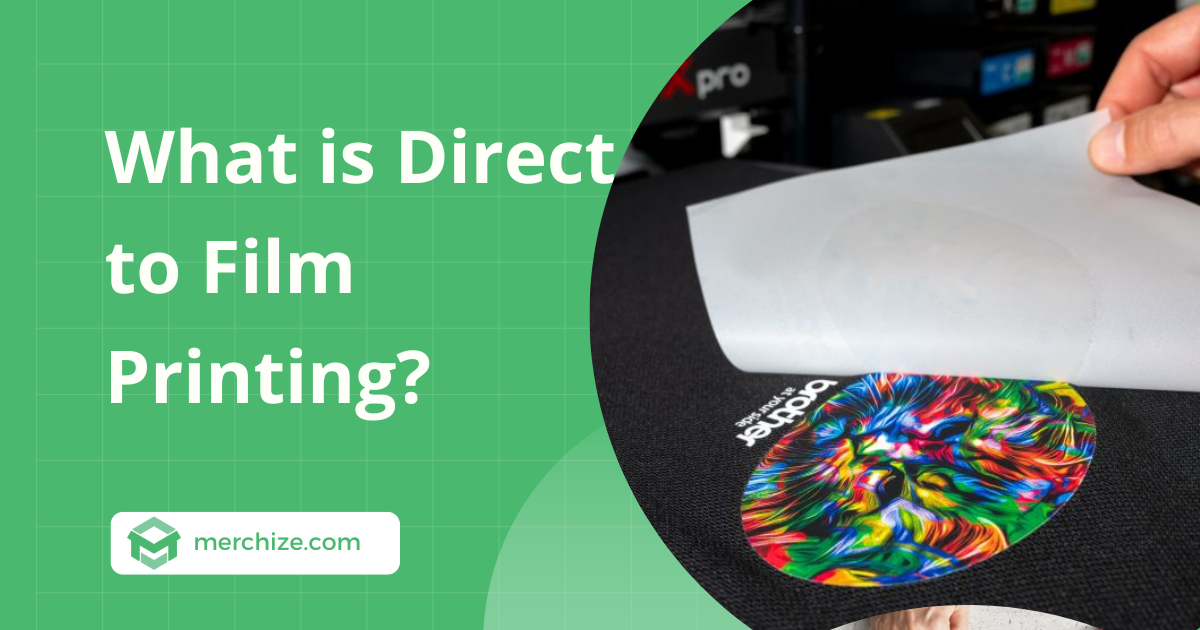Contents
What is Direct to film printing?
Direct-to-film or DTF is a print technique. Compared to other printing methods, DTF is a more recently developed invention.
During the process of DTF printing, the designs will be printed onto a special transfer film and then transferred onto fabric or other substrates using heat and pressure.
The invention of DTF has broken many barriers in printing that no previous printing method could. With DTF, it’s possible to create high-quality prints on various materials, from cotton to polyesters or blends. Before DTF, there wasn’t a printing technique that had such a wide range of applications. Even more impressive, DTF can ensure high-quality, durable printing at a low cost, compared to other printing methods.
How does Direct to film printing work?
The process of Direct-to-film printing is quite similar to the current printing techniques. However, it comes with a few twists. These twists are the secret ingredients that allow the magic to happen.
Let’s break down the DTF printing process to understand how this magic is formulated:
1. Create and design
Before the actual printing process, let’s talk about the design first. Each printing technique might have certain design preferences or ranges where it can show the best results.
However, with DTF, there aren’t many limitations on what kind of designs can be printed with DTF. This versatile printing method can handle any design, from graphic designs with multiple bold colors, and complex elements to photographic images with intricate details, and even difficult designs like gradients.
You can experience a different type of designs with DTF printing. But still, due to limitations in the printing area, you won’t be able to create all-over prints like with dye sublimation.
2. Print to film
Similar to other types of transfer printing techniques, DTF also uses a special transfer material to transfer prints to substrates. And the transfer material in question here is a PET (Polyethylene Terephthalate) film.
Now, you can print your design directly onto the PET film. It should be noted that the PET film won’t work with regular printers. You must use a DTF printer which runs on special pigment-based inks. This type of ink is well-known for its durability and vibrant colors.
3. Apply powder
In the next step, we will apply a layer of adhesive power to the freshly printed film while the ink is still wet. You can either spread the power manually or use a special automatic power-shaking machine.
This special power is the secret ingredient that works behind the magic of DTF printing. The powder acts as an adhesive that bonds the printed ink on the film to the fabric. Under the heat, the powder will melt and create a strong bond between the ink and the fabric, ensuring the design stays in place even after washing and regular use.
The use of power is particular to the DTF printing method. For example, screen printing doesn’t require any special adhesion agent. However, the printing will be less durable for certain fabrics. DTG, on the other hand, relies on a pre-treatment solution to bond the ink with fabric fibers. This mechanism works well on cotton but renders less effective on synthetic fabrics like polyester.
HTV doesn’t use adhesive power but includes heat-activated adhesive on the vinyl. When applying this vinyl over the fabric under high heat, the adhesive is activated and bonds to the material. The catch here is vinyl can only work with limited solid colors, which is suitable only for simple designs.
4. Cure film
Following the power application step is the curing process. At this point, the film with the applied powder is heated to cure the powder. The high temperature will melt the adhesive, ensuring it sticks to the ink and creates a ready-to-transfer print.
Curing can be done using a heat press, curing oven, or other heating equipment. The key here is to ensure that the heat is applied evenly at a specific temperature and duration.
5. Transfer design to garment
Before heat-pressing the new designs onto the fabric, you must pre-press the fabric in 2-5 seconds to iron out the surface and dehumidify the fabric.
Next, you can place the PET film on the fabric and align it correctly. Set the heat press at a temperature of 160-170 Celcus temperature for 15-20 seconds. The power-filled side should face directly to the fabric. Under the heat, the power will melt and bond the films into the fabric.
6. Peel off the film
Wait until the fabric cools off and then you can peel the film of the fabric. When you remove the film, the print remains attached to the fabric.
To even enhance the durability of the prints further, you can briefly heat press the fabric for one last time in just 10-15 seconds.
The final result is a high-quality print with vibrant colors and a soft hand feel.
Why use Direct to film printing?
Since its introduction, DTF printing has rapidly gained popularity due to its versatility, cost-effectiveness, and ability to produce high-quality prints on a wide range of materials. It continues to evolve with ongoing improvements in technology and materials, making it a preferred choice for many in the custom apparel and garment printing industry.
Wide applications
What makes DTF the new ideal printing choice is its versatility. This printing technology is applicable to a wide range of materials, from natural fiber fabrics like cotton, silk, and even leather to synthetic fiber like polyester, blends, nylon, and more.
This versatility sets it apart from other printing methods that are generally restricted to use on certain types of materials. For example, Direct to Garment (DTG) can only handle cotton, and dye sublimation works exclusively with synthetic polyester fabrics.
High printing quality
Another impressive attribute of DTF printing is its ability to deliver high-quality printing. With this printing technique, your creativity won’t be held back by any of the printing limitations. From bold colors to intricate details, DTF printing can handle everything with no hustle.
- Vibrant Colors: The pigment-based inks used in DTF printing produce bright, vivid colors with excellent detail.
- High Detail: DTF printing excels at producing intricate designs and fine details, which can be challenging for screen printing and other traditional methods. This method allows for printing complex designs with fine details and gradients that might be challenging for other printing methods.
Durability
Durability is among the most crucial criteria to take into consideration when selecting printing techniques. Even when a piece is made of the highest quality material, it would mean nothing if the print would just fade and peel off after a few washes.
With DTF, you can rest assured that none of these issues would be a problem. Thanks to the magic ingredient of adhesive power, the prints are bonded securely into the fabrics.
Cost-effective
Business-wise, cost is a top important factor that decides the possibility of adopting a printing technique. In this facade, DTF is also considered a good option, especially for small or medium order volumes.
Compared to options like screen printing, DTF is significantly more cost-effective for short production runs and custom orders as it doesn’t require a complicated setup to print each design.
However, it might require specific machinery to start with, for example, a dedicated DTF printer, heat press printer, or possibly an automatic power-shaking machine. If you just start as a small business, it wouldn’t be cost-efficient to invest in DTF.
Flexibility
With its simple operation, DTF is ideal for making custom print orders. This printing technique can handle one design at a time, allowing more flexibility for customization and personalization. Changes to designs can be made quickly without the need for new screens or complicated setup changes.
Thanks to its high flexibility and customization, DTF is considered an ideal option for print-on-demand orders.
DTF printing compared to other print methods
Direct-to-film vs. screen printing
Unlike DTF, screen printing is an old printing method invented way before recent developments in printing technology. Screen printing and its simple process don’t require expensive machinery but some stencils to transfer printing onto the fabric.
However, it also comes with a lot of limitations. For example, it couldn’t print complex, photographic designs like DTF. Moreover, the color range for screen printing is also restricted.
The screen printing process looks simple yet it demands some of the most extensive setups. To print just one design, you might have to create different stencils, which costs you not only time but also money to spend.
That’s why screen printing is preferred for large-volume printing orders. On the other hand, DTF works best for small, customer orders as it allows simple design setup, therefore, better flexibility.
Direct-to-film vs. direct-to-garment printing
Direct-to-garment printing and direct-to-film share one similar trait: Both can provide the level of flexibility and customization that meet the needs of print-on-demand businesses.
But these two printing techniques are essentially different. DTF is a type of transfer printing, while DTG prints by spraying ink directly into the fabric with specialized inkjet printers.
In terms of application, DTG is limited to only cotton or cotton-blend fabrics. But DTF can work on different types of fabrics from synthetic to natural fiber materials.
If you prefer versatility, DTF is definitely the better choice out of the two.
Direct-to-film vs. sublimation printing
Both DTF and Sublimation printing are categorized under the heat transfer printing section. However, each applies a different technique and principle. DTF uses heat-activated power to embed print onto fabric while sublimation’s bonding agent is the special ink that transforms from solid to gas under heat.
While sublimation is considered quite advanced, it is still a few steps behind the new DTF printing technique in terms of versatility. Sublimation only works on synthetic fabrics like nylon or polyester. And the colors only show on white or light-colored fabric.
However, there are a few things that only sublimation can deliver: It can create highly durable prints that melt into one with the fabric. This feature makes it possible for the fabric to withstand all the cutting and sewing after printing, which allows you to make all-over print designs.





